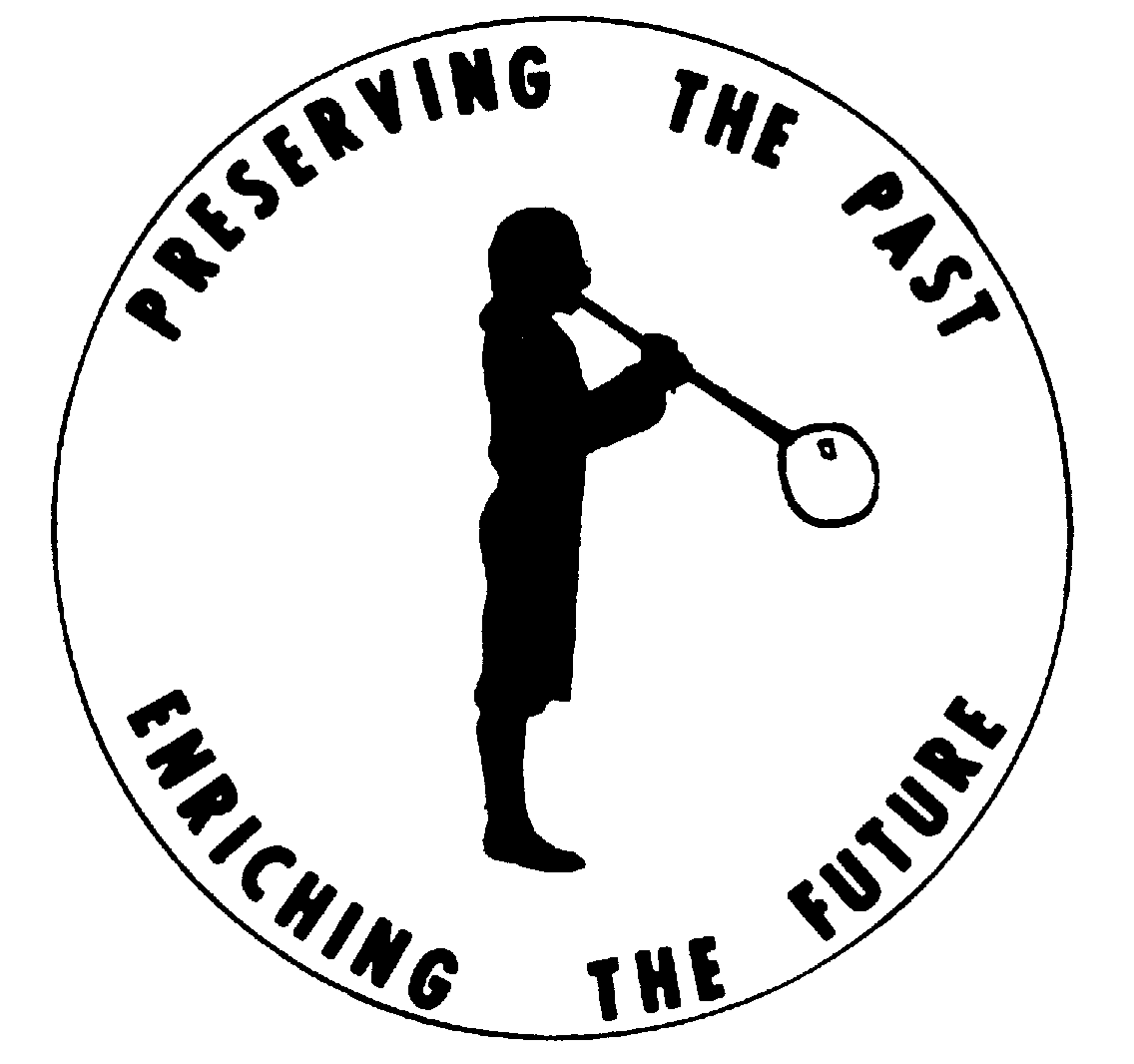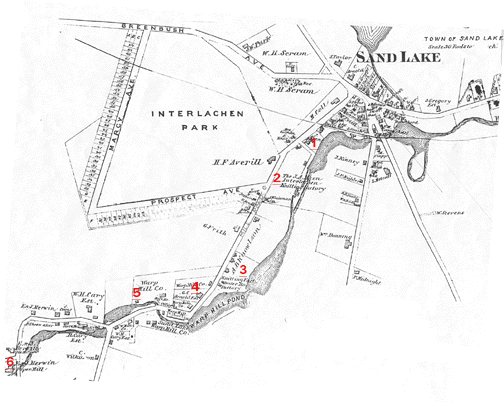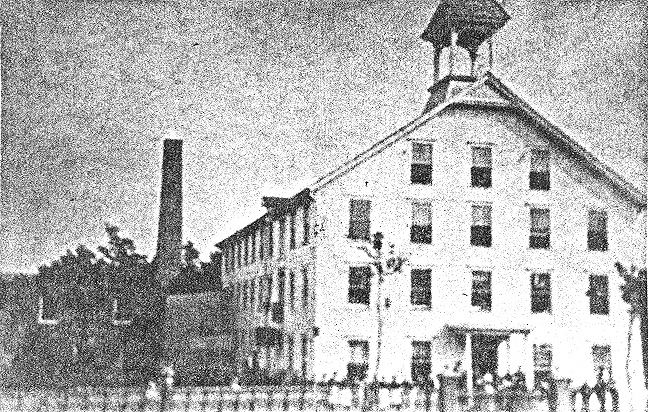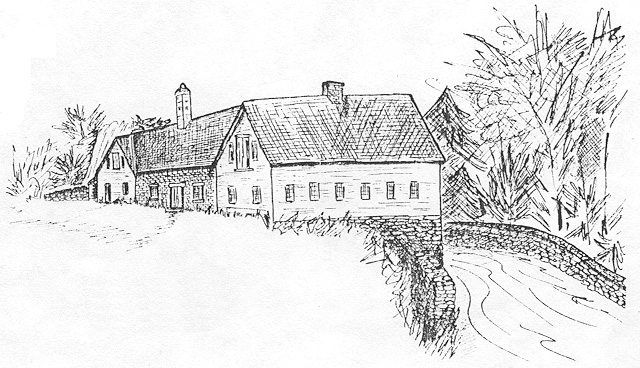
Historical Highlights
Sand Lake -- Mill Town?
It is hard to imagine, when driving through this quiet hamlet, that Averill Park was at one time a bustling mill town employing over 200 workers. Looking back, Averill Park in the 1800s was called the Hamlet of Sand Lake. Burden Lake Road was named Mill Road, and State Route 43 was the Albany-Sand Lake Plank Road. So let's start dreaming!
[Click on a number on the map to read about the mill located there...or just read on!]

We have rented a horse-drawn carriage from the local livery. We start out on our carriage tour by turning onto Mill Road from the Albany-Sand Lake Plank Road. Our first point of interest is the beautiful Victorian home of the Kane Family (#1 on the map above ). This house was built in the late 1850s by James Akin and acquired by Nicholas and Pierce Kane about 1870. The two Kane brothers, born in Ireland, came to this country and settled in West Troy. Both had an early introduction to the textile trade at the mills of Roy & Co. and became experts in knitting.
Pierce Kane was a superintendent of James Akin’s mill in Sand Lake, and, about 1880, Nicholas T. Kane bought the Mill. At his brother’s death in 1887, Pierce Kane became the owner.
Continuing along the road and looking to the left you can see the Hosiery Mill (#2) — a two-story wood frame building on the bank of the Wynantskill. The factory manufactured a medium grade of general hosiery, furnished employment to 85 persons, and used 360,000 pounds of raw material to produce 30,000 dozen pair of hosiery per year. The mill's five knitting machines were operated by waterpower from the Wynantskill.
Continuing down Mill Road we come to the A.B. Knowlson Beverwyck Factory (#3), on the site of the former John VanHoesen 1829 mill. In 1866, Knowlson had purchased the property and constructed a hosiery factory. This mill was destroyed by fire in 1874. A new mill was built by Andrew Knowlson and became known as the Beverwyck Hosiery Mill. The new mill was a large three-story wood frame building. The factory manufactured Gents, Ladies and Children's Beverwyck Hosiery, and knit shirts and drawers. A 16-foot fall of water was used to run its knitting machinery.

The Beverwyck Mill ran into financial trouble and closed its doors in 1896. (Today, some 120 years later, the upper Faith Mills building is at this location. If you look closely, you will see a small stone building — a remaining part of the boiler house of Andrew Knowlson's Beverwyck Mill. Click on picture to see a larger version.)
Before passing the mill, look up to the right and see the George Arnold home, built when Arnold owned the Sand Lake Cotton Factory.
Proceeding a short distance further along Mill Road, you come to the Sand Lake Cotton Factory (#4), operated as Arnolds, Hunt & Co. It was operated by The Arnold family until about 1875 when it failed. It was sold at auction in 1876 to Isaac McConihe.
The Averill Park factory manufactured cotton warp, both white and colored. It was a rather large operation housed in a 120’ x 40’ foot three-story wood frame building. The factory contained 2500 spindles using 7200 pounds of raw material a week. Its monthly payroll of $600 paid 40 employees. The factory failed in 1886; the machinery was removed and the mill abandoned.
Isaac McConihe, the last owner of the mill, was born in Troy, March 31, 1830, the son of Judge Isaac McConihe. He earned a degree from Hamilton Collage in 1849. McConihe was also president of the Troy Hosiery Co in Albia. As well as his involvement in manufacturing he was active in the City of Troy. He was an Alderman in 1853, Mayor in 1860-61 and Police Commissioner in 1880. Isaac McConihe died January 10, 1903.
A few rods down the road and across a wood bridge, note the sound of the horses hooves on the wood planking as we come to the site of the 1820 Albertson cloth dressing factory (#5). On Albertson’s death it became Rubin Chapman, then Clark and Hopkins. In 1846, Cornelius Schermerhorn had a wool mill on this site. Schermerhorn operated the mill until 1868, when it was sold at auction.
William H. Cary bought the mill and operated it as a knitting mill until his death in 1875. It was then auctioned on the steps of the Rensselaer Court House. The mill was equipped with three sets of knitting and other machinery, shafting, hangers, pulleys, steam boiler and pipes, tools and implements used in operating the mill, soaps, oils, about 10 cords of wood, paper boxes, box board, etc.
The mill never operated again after that 1875 auction. No sign of the mill can be found today, but across the road is the home that Albertson built in the early 1800s.

By this time our horse is ready to return to the barn. But in our carriage ride of about 3/4 mile we have passed four water-powered factories that employed many people and produced knit cotton and woolen goods, warp yarn and paper. That was Averill Park in the late 1880s!
Picture credits. The map is from the F. W. Beers map of 1876, with "…the mills dams and mill ponds along the Wynantkskill…shown." The "Artist's Conception" of the Staats Tompkins/Andrew J. Smart mill was drawn by Grace Patterson in 1981 and featured in an SLHS House Tour booklet. © 2000; from the Winter 2000 issue of Historical Highlights [See also Burden Lake.]